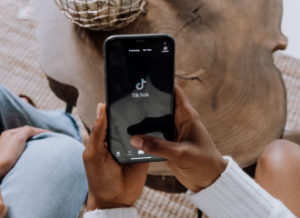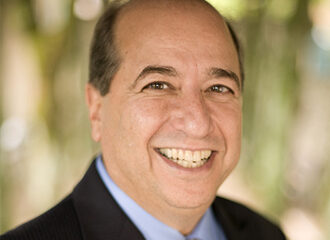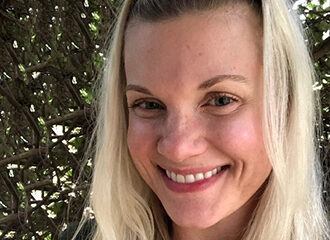With 834 million users worldwide, TikTok is one of the most popular forms of social media. The short-form, video-sharing social media platform allows its users to post content on almost any topic— including eating disorders. In this post, we look at what that means for users in recovery.
With its massive number of users, it’s no surprise food, exercise and eating disorders are some of the most talked-about topics on TikTok. Despite this, not all eating disorder content on TikTok is bad.
TikTok Eating Disorder Content: The Good

Social media can also be a way to expand our worldview by seeking out creators who are diverse in body types, abilities, genders, races, and ethnicities to proactively challenge the “ideals” pushed on us by the media.
[For more, check out our podcast episode: Social Media & Mental Health: A candid conversation with TikTok psychologist Dr. Paula Freedman]
TikTok Eating Disorder Content: The Bad
However, there are also videos of people encouraging dieting, sharing what they eat in a day, posting before and after “transformations,” and promoting disordered behaviors that can cause significant distress to those in recovery.
While TikTok has taken the initiative to filter eating disorder content and provide support resources when one searches terms such as “eating disorders,” videos without those specific tags still manage to slip through the cracks.
Interacting with one of these videos in any way can lead to your “For You Page” becoming flooded with eating disorder and food-related videos. For example, following certain creators, commenting, sharing, or even watching a video the entire way through can affect what the algorithm chooses to show you in the future. This means that even if you interacted with the more “positive” videos, some of the more triggering content can still land on your page.
Can TikTok Cause an Eating Disorder?
Eating disorders are complex psychiatric conditions and various factors contribute to both the onset of the disorder and maintenance of its symptoms. Research suggests that the onset of an eating disorder seems to occur due to a complex interaction between genetics and environment. Social media may contribute to environmental risk; there is ample research establishing a link between social media use and body dissatisfaction, eating concerns, and drive for thinness.
Studies have shown that social media use can also lead to an increase in mental health concerns like depression and anxiety in young people, and that exposure to eating disorder content in particular can be especially harmful.
An estimated 40.7% of TikTok users in the United States are under 30, with 25% of them being between 10 to 19 years of age, but for every user, regardless of age, it’s important to be aware of what you’re consuming and curate a feed that will support your mental health and recovery journey.
Here are some tips to help you along the way.
9 Tips for Navigating TikTok with an Eating Disorder
If you find yourself struggling to cope with the content you’re consuming, here are some tips to help you navigate platforms like TikTok and hopefully improve your relationship with social media.
- Disengage with “bad” videos and use mindfulness to stay in the present. Keep scrolling or step away from the app. Using mindfulness techniques, such as scented lotion or square breathing, can help you remain anchored in the moment.
- Disconnect from social media and connect with supports instead. Take time away from TikTok and other social media applications. Spend more time in the spaces where you feel seen, safe, valued, and validated in the body you exist in today. If you don’t have those spaces, seek them out.
- Unfollow, hide, or block anyone posting information or advice about food who isn’t a registered, weight neutral, anti-diet dietician. Do the same for anyone who negatively impacts your mood, increases your urges to compare, or heightens urges to engage in harmful behaviors, like restricting, bingeing, purging, or over-exercising.
- Report pro-ED content. It’s best for everyone, even if it doesn’t seem like it.
- Limit screen time either in the app or through your phone settings. For example, in TikTok’s settings, turning on “screen time breaks” will alert you when it’s time to take a break. You can also set a customized limit on “daily screen time”. When you hit your limit, a password would be required to continue using the app (you can give that password to a trusted support person so that you’re not tempted to use it). Under content preferences, you can also filter videos by using certain keywords, like “diet”. If that keyword appears in a video’s description or stickers, you won’t see that video in your feed.
- Delete the app if you find it to be too triggering or get someone else to do it if you are unable to do it yourself.
- Seek out media literacy courses to gain the tools needed to make sense of the messages and images you encounter online. Media Literacy Programs can help you think critically and shift the way you’re interpreting triggering content.
- Use creativity to express and validate your emotions. Take time to create something, such as a painting, drawing, poem, or song to help you explore your emotions. This can be especially important when supports are unavailable!
- Follow @RenfrewCenter and other recovery focused accounts to make sure your feed only shows encouraging, helpful posts.
Conclusion
While these steps are not going to instantly change our relationship with ourselves or our social media accounts, they’re a start! The more we can engage mindfully while scrolling, create boundaries around our use, and connect with people in our real lives, the less we set ourselves up with unrealistic expectations and feelings of unworthiness.



